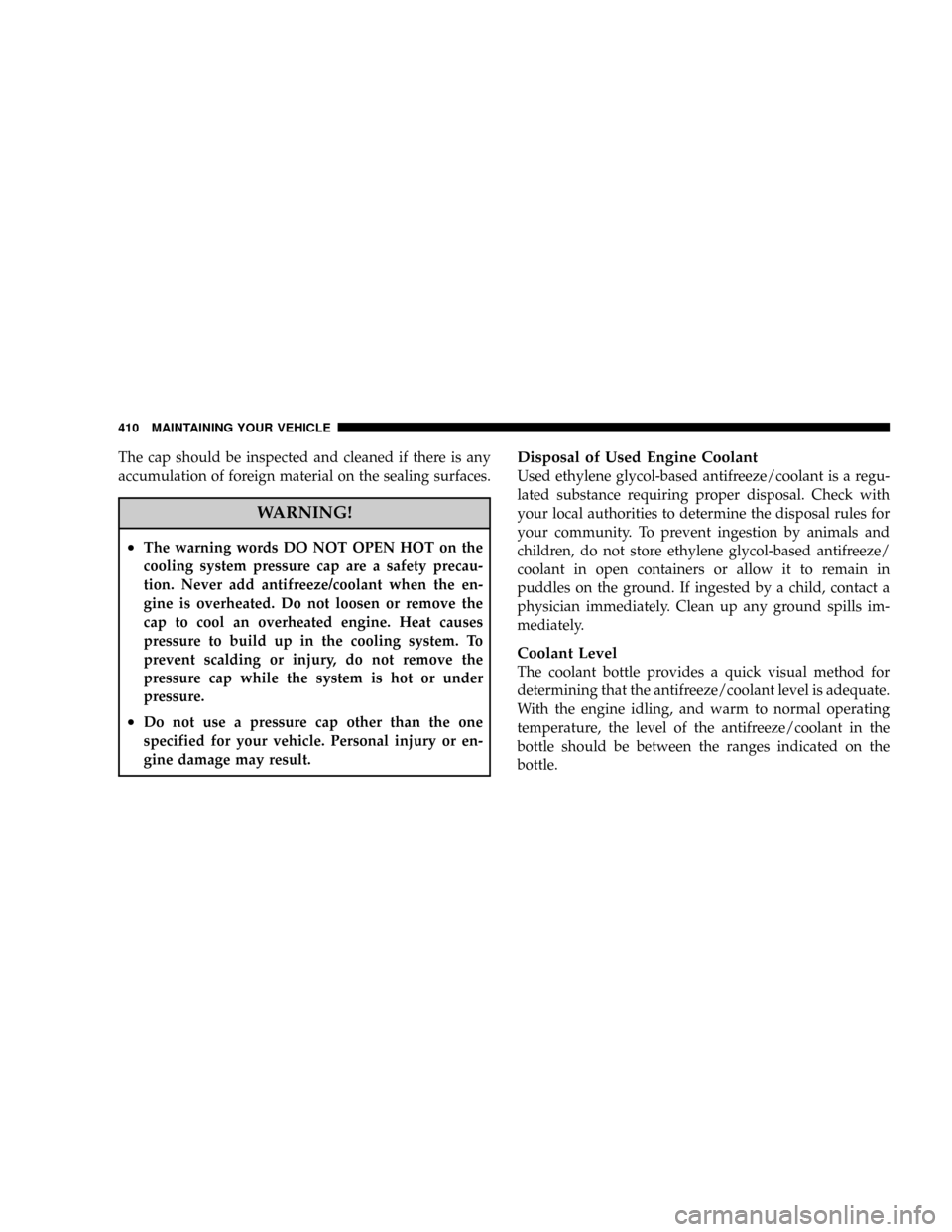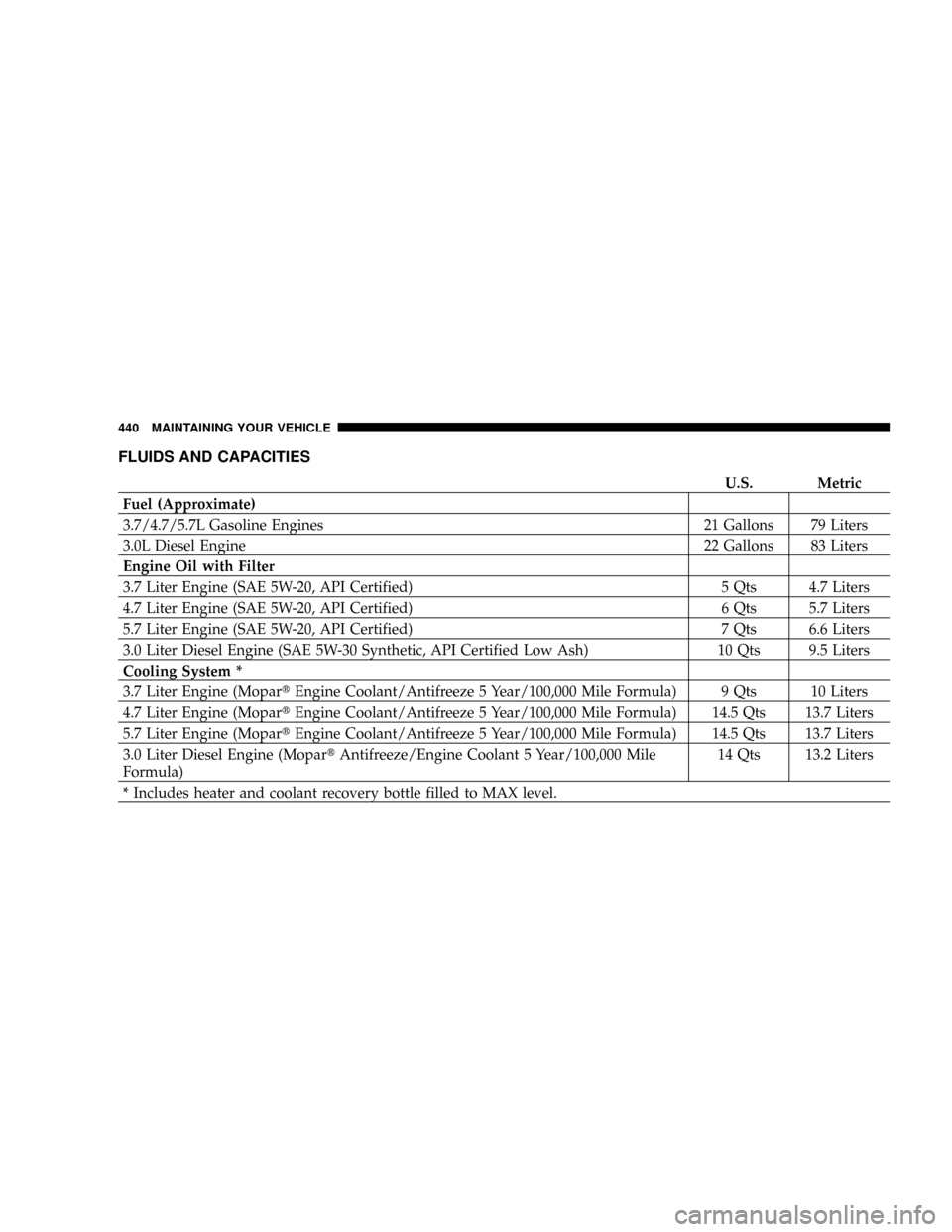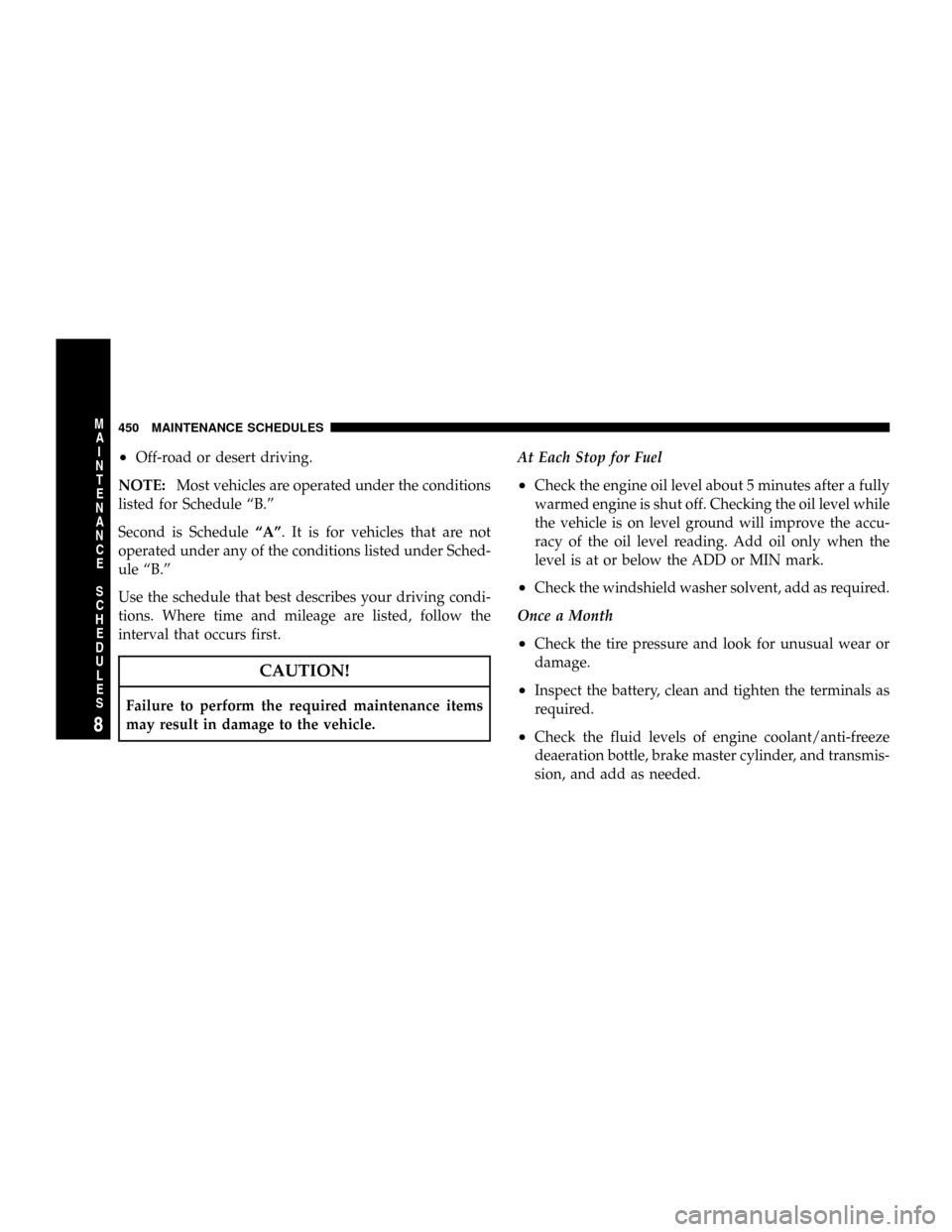2008 JEEP GRAND CHEROKEE coolant level
[x] Cancel search: coolant levelPage 199 of 490

²HOOD/GATE/DOOR OPEN (with graphic)
²HOOD/GATE/DOORS OPEN (with graphic)
²LIFTGLASS/DOOR OPEN (with graphic)
²LIFTGLASS/DOORS OPEN (with graphic)
²LIFTGLASS/HOOD OPEN (with graphic)
²WASHER FLUID LOW (with graphic)
²COOLANT LOW (with graphic)
²OIL CHANGE REQUIRED
²OIL CHANGE RESET
²CHECK GAUGES
²AUTO HIGH BEAMS ON
²AUTO HIGH BEAMS OFF
²PARK ASSIST DISABLED
²SERVICE SUSPENSION
²SERVICE PARK ASSIST SYSTEM
²TRANSMISSION OVER TEMP
²CHECK SHIFT PROCEDURE
²SERVICE 4WD SYSTEM
²4WD SYSTEM IN NEUTRAL
²LOW BRAKE FLUID LEVEL
²WARNING! LIMIT SPEED
²CHECK GASCAP
²ESP OFF
²IOD FUSE OUT
²HILL DESCENT CONTROL
²MEMORY #1 POSITIONS SET
UNDERSTANDING YOUR INSTRUMENT PANEL 199
4
Page 289 of 490

²the transmission selector is in D (Drive);
²the engine coolant has reached normal operating tem-
perature;
²vehicle speed is above approximately 30 mph (48
km/h);
²the ªTOW/HAULº switch has not been activated;
²transmission has reached normal operating tempera-
ture.
NOTE:If the vehicle is started in extremely cold tem-
peratures, the transmission may not shift into Overdrive
and will automatically select the most desirable gear for
operation at this temperature. Normal operation will
resume when the transmission fluid temperature has
risen to a suitable level. Refer also to the Note under
torque converter clutch, later in this section.During cold temperature operation you may notice de-
layed upshifts depending on engine and transmission
temperature. This feature improves the warm up time of
the engine and transmission.
If the transmission temperature gets extremely hot, the
transmission will automatically select the most desirable
gear for operation at this temperature. If the transmission
temperature becomes hot enough, the ªTRANSMISSION
OVER TEMPº message may display and the transmis-
sion may downshift out of Overdrive until the transmis-
sion cools down. After cool down, the transmission will
resume normal operation.
In high ambient temperatures with sustained high engine
speed and load, an upshift followed shortly thereafter by
a downshift may occur. This is a normal part of the
overheat protection strategy when operating in the
ªTow/Haulº mode.
STARTING AND OPERATING 289
5
Page 409 of 490

Adding Coolant
Your vehicle has been built with an improved antifreeze/
coolant that allows extended maintenance intervals. This
antifreeze/coolant can be used up to 5 Years or 100,000
miles (160 000 km) before replacement. To prevent reduc-
ing this extended maintenance period, it is important that
you use the same antifreeze/coolant throughout the life
of your vehicle. Please review these recommendations for
using Hybrid Organic Additive Technology (HOAT)
antifreeze/coolant.
When adding antifreeze/coolant:
²The manufacturer recommends using Mopart
Antifreeze/ Coolant 5 Year/100,000 Mile Formula
HOAT (Hybrid Organic Additive Technology)
²Mix a minimum solution of 50% HOAT engine coolant
and distilled water. Use higher concentrations (not to
exceed 70%) if temperatures below -34ÉF (-37ÉC) are
anticipated.
²Use only high purity water such as distilled or deion-
ized water when mixing the water/antifreeze (cool-
ant) solution. The use of lower quality water will
reduce the amount of corrosion protection in the
engine cooling system.
Please note that it is the owner's responsibility to main-
tain the proper level of protection against freezing ac-
cording to the temperatures occurring in the area where
the vehicle is operated.
NOTE:Mixing antifreeze/coolant types will decrease
the life of the antifreeze/coolant and will require more
frequent antifreeze/coolant changes.
Cooling System Pressure Cap
The cap must be fully tightened to prevent loss of
antifreeze/coolant, and to insure that antifreeze/coolant
will return to the radiator from the coolant recovery tank.
MAINTAINING YOUR VEHICLE 409
7
Page 410 of 490

The cap should be inspected and cleaned if there is any
accumulation of foreign material on the sealing surfaces.
WARNING!
²The warning words DO NOT OPEN HOT on the
cooling system pressure cap are a safety precau-
tion. Never add antifreeze/coolant when the en-
gine is overheated. Do not loosen or remove the
cap to cool an overheated engine. Heat causes
pressure to build up in the cooling system. To
prevent scalding or injury, do not remove the
pressure cap while the system is hot or under
pressure.
²Do not use a pressure cap other than the one
specified for your vehicle. Personal injury or en-
gine damage may result.
Disposal of Used Engine Coolant
Used ethylene glycol-based antifreeze/coolant is a regu-
lated substance requiring proper disposal. Check with
your local authorities to determine the disposal rules for
your community. To prevent ingestion by animals and
children, do not store ethylene glycol-based antifreeze/
coolant in open containers or allow it to remain in
puddles on the ground. If ingested by a child, contact a
physician immediately. Clean up any ground spills im-
mediately.
Coolant Level
The coolant bottle provides a quick visual method for
determining that the antifreeze/coolant level is adequate.
With the engine idling, and warm to normal operating
temperature, the level of the antifreeze/coolant in the
bottle should be between the ranges indicated on the
bottle.
410 MAINTAINING YOUR VEHICLE
Page 411 of 490

The radiator normally remains completely full, so there is
not need to remove the radiator cap unless checking for
antifreeze/coolant freeze point or replacing antifreeze/
coolant. Advise your service attendant of this. As long as
the engine operating temperature is satisfactory, the
coolant bottle need only be checked once a month.
When additional antifreeze/coolant is needed to main-
tain the proper level, it should be added to the coolant
bottle. Do not overfill.
Points To Remember
NOTE:When the vehicle is stopped after a few miles
(kilometers) of operation, you may observe vapor coming
from the front of the engine compartment. This is nor-
mally a result of moisture from rain, snow, or high
humidity accumulating on the radiator and being vapor-
ized when the thermostat opens, allowing hot antifreeze/
coolant to enter the radiator.If an examination of your engine compartment shows no
evidence of radiator or hose leaks, the vehicle may be
safely driven. The vapor will soon dissipate.
²Do not overfill the coolant recovery bottle.
²Check antifreeze/coolant freeze point in the radiator
and in the coolant recovery bottle. If antifreeze/
coolant needs to be added, contents of coolant recov-
ery bottle must also be protected against freezing.
²If frequent antifreeze/coolant additions are required,
or if the level in the coolant recovery bottle does not
drop when the engine cools, the cooling system should
be pressure tested for leaks.
²Maintain antifreeze/coolant concentration at 50%
HOAT antifreeze/coolant (minimum) and distilled
water for proper corrosion protection of your engine
which contains aluminum components.
MAINTAINING YOUR VEHICLE 411
7
Page 440 of 490

FLUIDS AND CAPACITIES
U.S. Metric
Fuel (Approximate)
3.7/4.7/5.7L Gasoline Engines 21 Gallons 79 Liters
3.0L Diesel Engine 22 Gallons 83 Liters
Engine Oil with Filter
3.7 Liter Engine (SAE 5W-20, API Certified) 5 Qts 4.7 Liters
4.7 Liter Engine (SAE 5W-20, API Certified) 6 Qts 5.7 Liters
5.7 Liter Engine (SAE 5W-20, API Certified) 7 Qts 6.6 Liters
3.0 Liter Diesel Engine (SAE 5W-30 Synthetic, API Certified Low Ash) 10 Qts 9.5 Liters
Cooling System *
3.7 Liter Engine (MopartEngine Coolant/Antifreeze 5 Year/100,000 Mile Formula) 9 Qts 10 Liters
4.7 Liter Engine (MopartEngine Coolant/Antifreeze 5 Year/100,000 Mile Formula) 14.5 Qts 13.7 Liters
5.7 Liter Engine (MopartEngine Coolant/Antifreeze 5 Year/100,000 Mile Formula) 14.5 Qts 13.7 Liters
3.0 Liter Diesel Engine (MopartAntifreeze/Engine Coolant 5 Year/100,000 Mile
Formula)14 Qts 13.2 Liters
* Includes heater and coolant recovery bottle filled to MAX level.
440 MAINTAINING YOUR VEHICLE
Page 445 of 490

²Change your engine oil more often if you drive your
vehicle off-road for an extended period of time.
²Under no circumstances should oil change intervals
exceed 6,000 miles (10,000 km) or 6 months, whichever
comes first.
Your dealer will reset the oil change indicator message
after completing the scheduled oil change. If this sched-
uled oil change is performed by someone other than your
dealer the message can be reset by referring to the steps
described under ªOil Change Requiredº in ªUse Factory
Settingsº of the EVIC section in this manual.
At Each Stop for Fuel
²Check the engine oil level about 5 minutes after a fully
warmed engine is shut off. Checking the oil level while
the vehicle is on level ground will improve the accu-
racy of the oil level reading. Add oil only when the
level is at or below the ADD or MIN mark.
²Check the windshield washer solvent and add if
required.
Once a Month
²Check tire pressure and look for unusual wear or
damage.
²Inspect the battery and clean and tighten the terminals
as required.
²Check the fluid levels of coolant reservoir, brake
master cylinder, power steering and transmission and
add as needed.
²Check all lights and other electrical items for correct
operation.
MAINTENANCE SCHEDULES 445
8
M
A
I
N
T
E
N
A
N
C
E
S
C
H
E
D
U
L
E
S
Page 450 of 490

²Off-road or desert driving.
NOTE:Most vehicles are operated under the conditions
listed for Schedule ªB.º
Second is ScheduleªAº. It is for vehicles that are not
operated under any of the conditions listed under Sched-
ule ªB.º
Use the schedule that best describes your driving condi-
tions. Where time and mileage are listed, follow the
interval that occurs first.
CAUTION!
Failure to perform the required maintenance items
may result in damage to the vehicle.At Each Stop for Fuel
²Check the engine oil level about 5 minutes after a fully
warmed engine is shut off. Checking the oil level while
the vehicle is on level ground will improve the accu-
racy of the oil level reading. Add oil only when the
level is at or below the ADD or MIN mark.
²Check the windshield washer solvent, add as required.
Once a Month
²Check the tire pressure and look for unusual wear or
damage.
²Inspect the battery, clean and tighten the terminals as
required.
²Check the fluid levels of engine coolant/anti-freeze
deaeration bottle, brake master cylinder, and transmis-
sion, and add as needed.
450 MAINTENANCE SCHEDULES
8
M
A
I
N
T
E
N
A
N
C
E
S
C
H
E
D
U
L
E
S